The Joseph T. Jones Family: 267 North Street
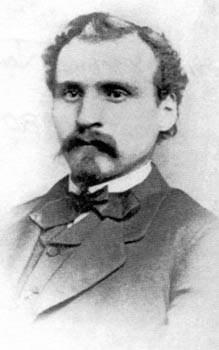 Joseph T. Jones c. 1880. Image source: Oil Region Alliance
Joseph T. Jones c. 1880. Image source: Oil Region Alliance
The life story of Joseph T. Jones is the quintessential American story of a poor boy making his fortune by intelligence, hard work, and good luck. Born in Philadephia in 1842, he grew up poor, his father having died when he was two. When the Civil War broke, he enlisted in the 91st Regiment of Pennsylvania Volunteers for three years. He survived the battles of Fredericksburg and Gettysburg, acquiring promotions regularly until he reached the ranks of Acting Captain in 1864, giving him the title which he used for the rest of his life. In the Battle of Cold Harbor in June, 1864, a shell exploded at his feet, severly wounding both; he lay for 24 hours in a trench before aid reached him. He never fully recovered from these wounds, though they would not prove a hindrance in his quest for financial solvency for his mother and sister.
In 1865, he followed many others to the oil rush in western Pennsylvania to try his luck at drilling for oil. Twelve dry wells and two years later, he was out of money and credit, owing $6,000 in bank loans. [From the descendants: he was called "dry-hole Jones" before drilling the 13th well. They tell me that the number 13 is the family's lucky number today.] That thirteenth well was successful; he was 25 years old. Using shrewd business practices, he was able to store oil until prices went up, pay his debts, then construct a pipeline to transport oil from oil fields to railroads. This he merged with the Standard Oil Company in 1877. He then joined with another entrepreneur to form the Bradford Oil Company. When investors feared a glut of oil, he bought their shares and by 1883, he had 584 wells in production, more than any other individual oil producer in the country.
Along the way, he had met Melodia Blackmarr, born in Sinclairville, NY. Her father was a Methodist Episcopal minister. She was well educated, fluent in German and French, accomplished at the piano, and a graduate of Mount Union College. They married in 1876 had two children, Joseph Albert and Grace.
With his profits, Joseph T. Jones turned his attention to the booming Niagara Frontier, moving to Buffalo in 1893 to 1192 Delaware, into a house that had several previous owners.(The location is now covered by Canisius High School.) For some years, he commuted to his offices in Pennsylvania until 1900, when he moved his headquarters to the Prudential building in Buffalo. In this city, he invested in the Cataract Milling company (flour), the Pettibone Paper Mill in Niagara Falls, and was one of the founders of the scenic Great Gorge Route, a railway running along the Niagara River.
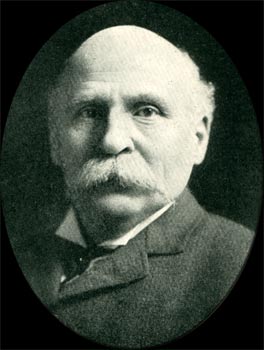
Joseph T. Jones, 1902. Image source: Men of Buffalo
In 1895, he determined to build a harbor on the Gulf of Mexico shores of Mississipi to permit shipment of timber from 63,000 acres of southern yellow pine which he owned. Despite U.S. governmental assurances that a deep water harbor could not be durably constructed at the location Jones desired, he invested $2 million dollars of his own money for the dredging and construction of dock facilities. To finish the transportation system he envisioned for the lumber business, he partnered with William Hardy to complete the construction of a 160-mile railroad, the Gulf and Ship Island Railroad, linking Biloxi to the harbor, which he called Gulfport. Between 1903 and 1907, a billion board feet of timber was shipped from Gulfport. From 1910- 1913, more timber was shipped from Gulfport than from any other port in the world. He had founded a city where none existed, constructing the headquarters building of the Gulf and Island Railroad and the huge Great Southern Hotel, where he and his family stayed while visiting. He formed the Gulfport Real Estate Improvements Company to build urban infrastructure, founded the First National Bank of Gulfport. He built a golf course and yacht club. The U.S. government, which had eschewed assistance in constructing the harbor, assumed responsibility for its management.
He was enormously wealthy, but his son died in 1910 at the age of 32. As a director of the Pan-American Exposition, he successfully challenged other wealthy Buffalonians by purchasing a total of $125,000 of Pan-American stock, which was not repaid because the exposition did not make a profit. He suffered setbacks from Gulf Coast hurricanes and national economic panics. Even after suffering a stroke in 1913 at Gulfport, he continued working with the assistance of his daughter.
In 1907, Captain Jones sold his property at 1192 Delaware to George Rand, Sr., who intended to build the grandest mansion on the avenue. He and his family moved to 267 North Street, to a house built in 1885 for John Bemis and designed by J.L. Silsbee.

The Jones home at 267 North Street.

The gardens behind the Jones home on North Street. (Now a parking lot.)
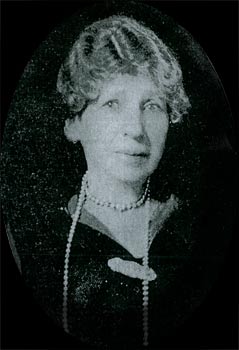
Melodia E. Jones c. 1929. Image source: Buffalo Evening News
Joseph T. Jones and his wife, Melodia, involved themselves in Buffalo organizations and philanthropy. After her husband's death in 1916, Mrs. Jones inherited an estate worth $15 million dollars. She was immediately named president of the Gulf and Ship Island Railroad, and managed the Great Gorge Route as well as "large enterprises in Chicago" and oil properties. She also expanded her philanthropic efforts in Buffalo, becoming a director of the Buffalo Association for the Blind. She donated $14,000 toward the purchase of a building at 180 Goodell to be the Association's new office and salesrooms with apartments above for blind couples. She was an active participant in the Tuberculosis Association's Christmas Seal drives; she gave $5,000 to establish a research department at the J.N.Adam Memorial Hospital to promote treatments for tuberculosis. She also made possible the purchase of a new home for that Association at 708 Ellicott Street. She also provided the Red Cross with a home. She gave $20,000 to the Buffalo Music Foundation And, in 1929, she donated $125,000 to the University of Buffalo for the endowment of a professorship in French, to be filled by a native French scholar. For this, the French government awarded her the Legion of Honor, France's highest honor; she was the first American woman to receive it.
When she died in her home on North Street on March 11, 1931, her honorary pall bearers included Frank B. Baird, Howard R. Bissell, Walter P. Cooke, Albert H. Schoellkopf, Dr. Conrad E. Wettlaufer, Julian Park, Sherman Jewett, H. M. Gerrans, etc. Buffalo Truth magazine said of her, "...she lived and numberless beings, less fortunate, were better for her living. After all, this is what really matters in any appraisal of an individual life."

The entrance hall

The entrance hall viewed from the other direction.

The drawing room.

The music room.

The dining room.

The sun porch.
Descendents of Captain and Melodia Jones continued with philanthropic activities. Daughter Grace Jones Stewart, in 1935, donated a tract of land along the shore in Gulfport for the establishment of a park to honor her father; she was on the board of the New York Philharmonic Orchestra Society. Her son, Joseph T.J. Stewart, a graduate of the University of Buffalo in 1949, made Buffalo his lifelong home. He was part of the original investment group that founded the Buffalo Sabres, and he served for many years as Sabres treasurer. He was a founding trustee of the Buffalo General Foundation, and was active on the board of Hauptman-Woodward Medical Institute. Among his many other charitable activities, he gave an endowment that provides scholarships for UB Honors Program students.
The Melodia E. Jones Professorship in French continues at the University at Buffalo. To date, fifty-four professors or lecturers have held this chair.
In 1942, the citizens of Gulfport, Mississippi, erected a lifesize bronze statue atop a wide granite base to honor Captain J.T. Jones, the "city's greatest benefactor." In 2005, Hurricane Katrina toppled the statue; it was restored in February, 2010, with fanfare.
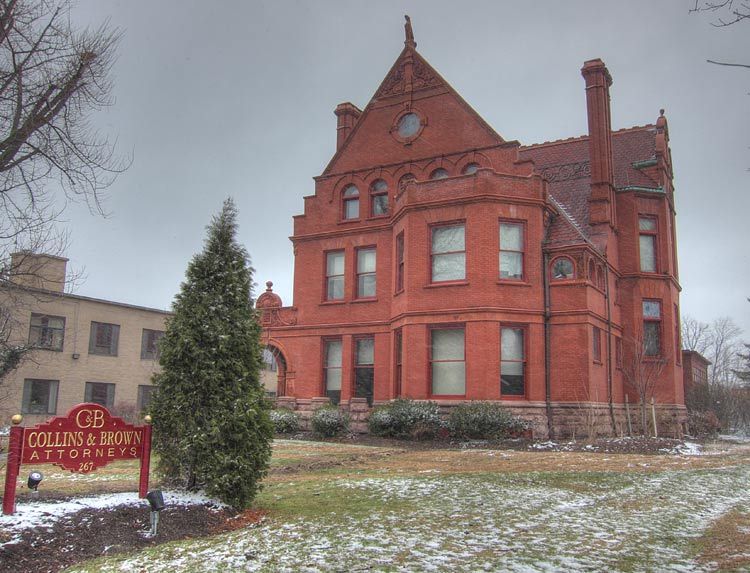
The Jones home remained in the family for 48 years until 1955 when, after his mother's death, Joseph T. J. Stewart sold the property to Philip Ransom. Today the structure is used for offices. In architectural circles, it is called the Bemis-Ransom house.
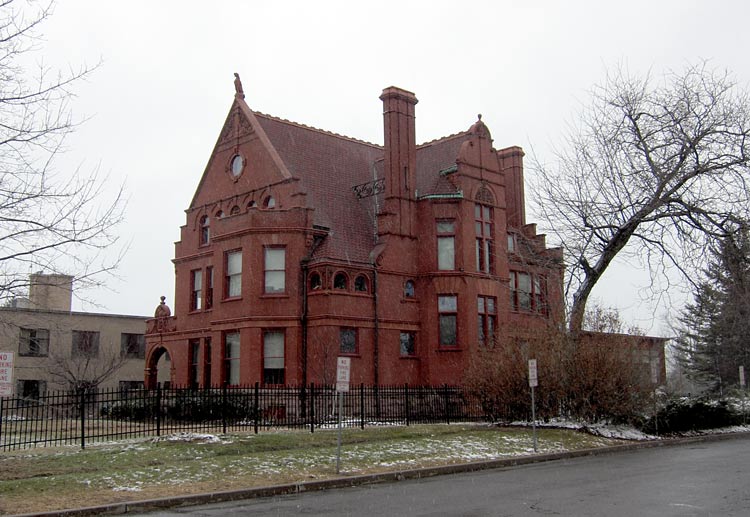
For information about the archtitecture of the house, see Buffalo as an Architectural Museum (takes you out of this site).
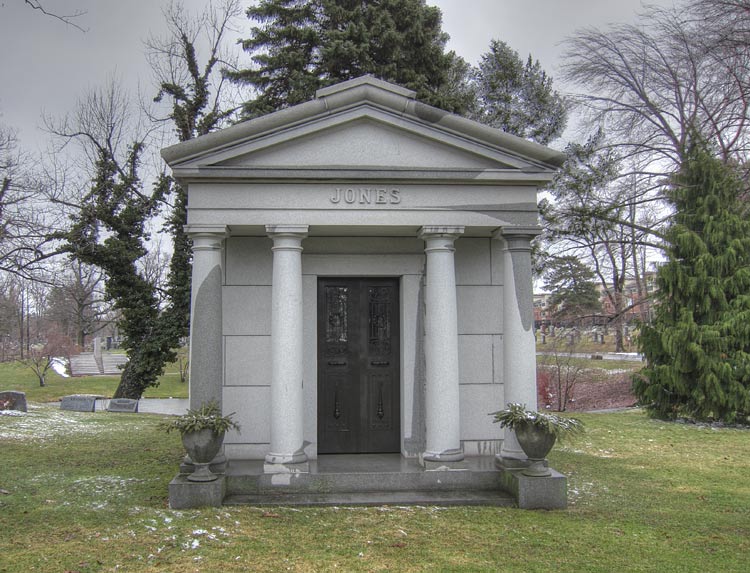
The Jones family mausoleum at Forest Lawn.